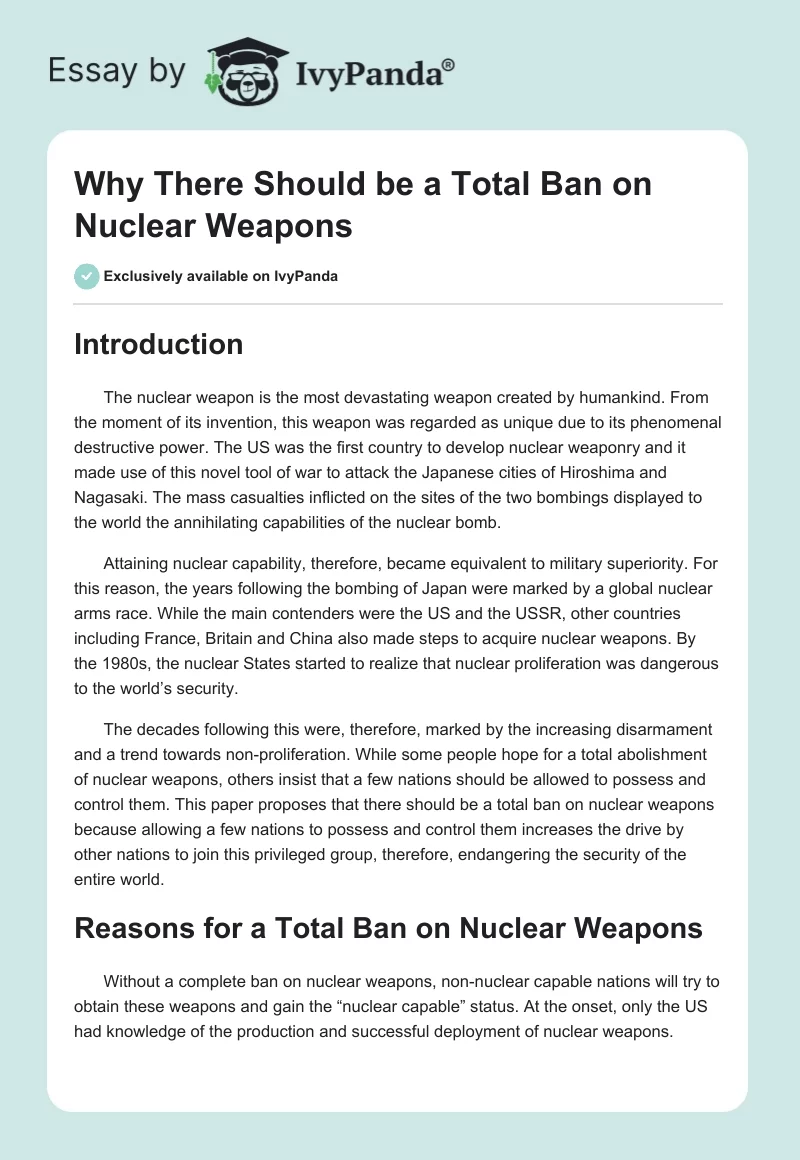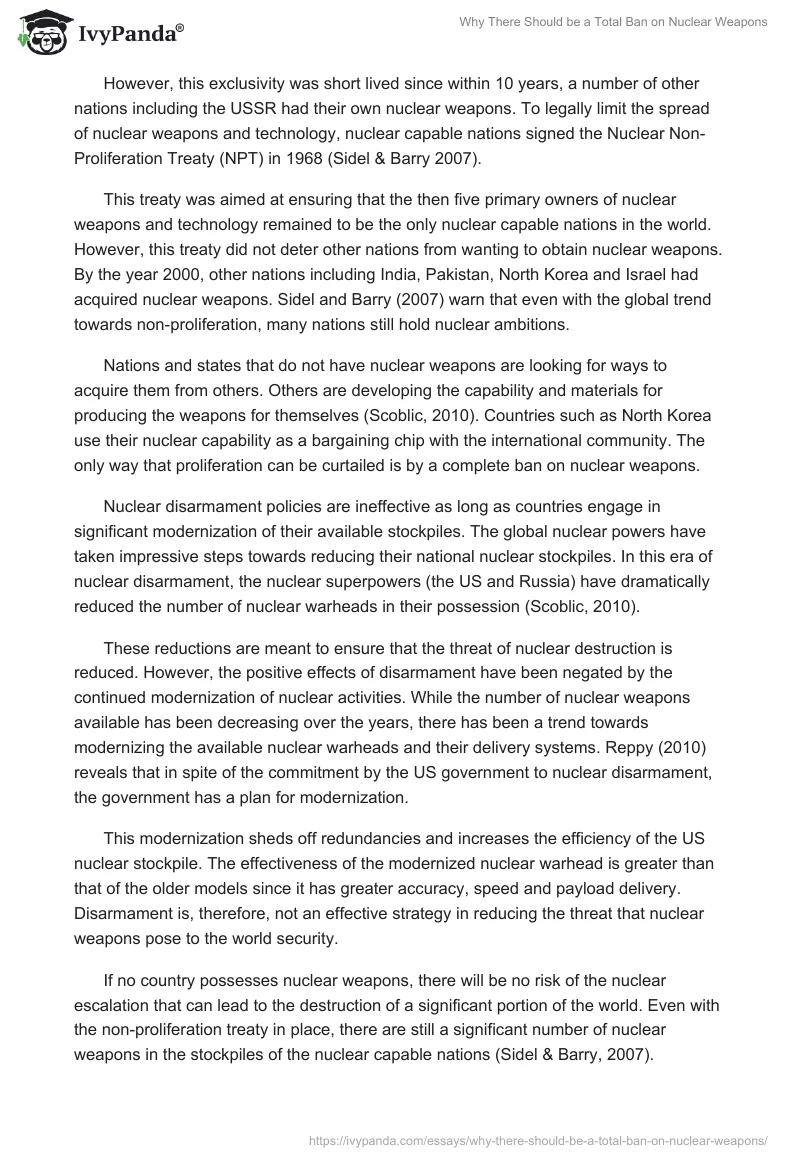Introduction
The nuclear weapon is the most devastating weapon created by humankind. From the moment of its invention, this weapon was regarded as unique due to its phenomenal destructive power. The US was the first country to develop nuclear weaponry and it made use of this novel tool of war to attack the Japanese cities of Hiroshima and Nagasaki. The mass casualties inflicted on the sites of the two bombings displayed to the world the annihilating capabilities of the nuclear bomb.
Attaining nuclear capability, therefore, became equivalent to military superiority. For this reason, the years following the bombing of Japan were marked by a global nuclear arms race. While the main contenders were the US and the USSR, other countries including France, Britain and China also made steps to acquire nuclear weapons. By the 1980s, the nuclear States started to realize that nuclear proliferation was dangerous to the world’s security.
The decades following this were, therefore, marked by the increasing disarmament and a trend towards non-proliferation. While some people hope for a total abolishment of nuclear weapons, others insist that a few nations should be allowed to possess and control them. This paper proposes that there should be a total ban on nuclear weapons because allowing a few nations to possess and control them increases the drive by other nations to join this privileged group, therefore, endangering the security of the entire world.
Reasons for a Total Ban on Nuclear Weapons
Without a complete ban on nuclear weapons, non-nuclear capable nations will try to obtain these weapons and gain the “nuclear capable” status. At the onset, only the US had knowledge of the production and successful deployment of nuclear weapons.
However, this exclusivity was short lived since within 10 years, a number of other nations including the USSR had their own nuclear weapons. To legally limit the spread of nuclear weapons and technology, nuclear capable nations signed the Nuclear Non-Proliferation Treaty (NPT) in 1968 (Sidel & Barry 2007).
This treaty was aimed at ensuring that the then five primary owners of nuclear weapons and technology remained to be the only nuclear capable nations in the world. However, this treaty did not deter other nations from wanting to obtain nuclear weapons. By the year 2000, other nations including India, Pakistan, North Korea and Israel had acquired nuclear weapons. Sidel and Barry (2007) warn that even with the global trend towards non-proliferation, many nations still hold nuclear ambitions.
Nations and states that do not have nuclear weapons are looking for ways to acquire them from others. Others are developing the capability and materials for producing the weapons for themselves (Scoblic, 2010). Countries such as North Korea use their nuclear capability as a bargaining chip with the international community. The only way that proliferation can be curtailed is by a complete ban on nuclear weapons.
Nuclear disarmament policies are ineffective as long as countries engage in significant modernization of their available stockpiles. The global nuclear powers have taken impressive steps towards reducing their national nuclear stockpiles. In this era of nuclear disarmament, the nuclear superpowers (the US and Russia) have dramatically reduced the number of nuclear warheads in their possession (Scoblic, 2010).
These reductions are meant to ensure that the threat of nuclear destruction is reduced. However, the positive effects of disarmament have been negated by the continued modernization of nuclear activities. While the number of nuclear weapons available has been decreasing over the years, there has been a trend towards modernizing the available nuclear warheads and their delivery systems. Reppy (2010) reveals that in spite of the commitment by the US government to nuclear disarmament, the government has a plan for modernization.
This modernization sheds off redundancies and increases the efficiency of the US nuclear stockpile. The effectiveness of the modernized nuclear warhead is greater than that of the older models since it has greater accuracy, speed and payload delivery. Disarmament is, therefore, not an effective strategy in reducing the threat that nuclear weapons pose to the world security.
If no country possesses nuclear weapons, there will be no risk of the nuclear escalation that can lead to the destruction of a significant portion of the world. Even with the non-proliferation treaty in place, there are still a significant number of nuclear weapons in the stockpiles of the nuclear capable nations (Sidel & Barry, 2007).
These weapons are active and countries such as the US, Russia and the UK have submarines fitted with nuclear weaponry patrolling the deep oceans in readiness to launch attacks in case the directive to do this is given. As long as nuclear weapons exist, there will always be a danger of their being used.
For example, the North Korean republic is constantly threatening to use its nuclear weapons against its Southern neighbor. This has been a course of intense tension in the region for many years. Sidel and Barry (2007) declare that the only way to address the danger of nuclear weapons is to eliminate them.
A Case for Nuclear Weapons
Nuclear weapons have a great deterrence effect and they prevent the outbreak of a large-scale military confrontation between the major world powers. For this reason, proponents of nuclear weapons argue that a few nations should be allowed to possess and control nuclear weapons.
Some senior government policy advisers hold the view that nuclear weapons were never meant to be used (Oelrich, 2012). This view is supported by the fact that these weapons have never been used in a military confrontation since the bombing of Hiroshima and Nagasaki in 1945. As such, the global nuclear arsenal is useful only for purposes of deterrence. The use of nuclear weapons by countries such as Russia, the US and China against each other would result in mutually assured destruction due to the second strike capability of each nation.
Since no country is prepared to expose itself to catastrophic destruction, nuclear weapons ensure that the major powers do not engage in direct military confrontations (Oelrich, 2012). There is no doubt that nuclear weapons play a significant role in deterrence. However, the weapons employed by the modern military are sophisticated and can cause significant damages. The major powers are, therefore, unlikely to engage each other in an armed conflict even without the threat of nuclear annihilation.
Another argument offered by nuclear weapon advocates is that these weapons offer a cheap security guarantee compared to the cost of force capabilities based solely on conventional forces. This argument is supported by the fact that nuclear weapons cause damage on a much larger scale than conventional weapons.
A historical example used to support this view is that the US made use of tactical nuclear weapons to counterbalance the USSR military threat to Europe during the Cold War years. While the USSR had a large conventional force, the US only used a few nuclear weapons to keep the Soviet threat at bay. Advocates of nuclear weapons, therefore, argue that having these weapons reduces the global military cost.
However, this view fails to consider the significant costs of developing nuclear weaponry and delivery systems. Reppy (2010) reveals that while nuclear weapons are immensely powerful, the cost of development and production of nuclear weapons is astronomical. It is estimated that the US spent $7.5 trillion between 1940 and 2005 to develop and sustain its nuclear capabilities (Reppy, 2010). This demonstrates that nuclear weapons are expensive and their alleged benefit as a cheap security guarantee is unfounded.
Conclusion
The paper set out to show that nuclear weapons should be completely banned. It began by demonstrating the military significance of nuclear weapons. It noted that while only a few nations possess nuclear weapons currently, many other nations hold nuclear ambitions.
The paper also highlighted the inadequacies of the disarmament policies currently in place. However, the paper has illustrated some of the reasons why it would be desirable for some nations to possess and control nuclear weapons. These weapons have a significant deterrence effect preventing major military confrontations.
While this effect is desirable for world security, nuclear weapons are not the only means through which deterrence can be achieved. Both opponents and proponents of complete nuclear disarmament agree that nuclear weapons pose a particularly destructive threat to the world. The alleged benefits of nuclear weapons to global security do not justify the dangers that the weapons pose. As such, the nuclear threat should be eliminated through a total ban on nuclear weapons.
References
Oelrich, I. (2012). The next step in arms control: Eliminate the counterforce mission. Bulletin of the Atomic Scientists, 68(1), 79-85.
Reppy, J. (2010). U.S. nuclear laboratories in a nuclear-zero world. Bulletin of the Atomic Scientists, 66(4), 42-57.
Sidel, V., & Barry, L. (2007). Proliferation of nuclear weapons: Opportunities for control and abolition. American Journal of Public Health, 97(9), 1589-1594.
Scoblic, P. (2010). What are nukes good for? New Republic, 241(6), 22-27.


